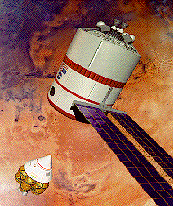 A
Crewed Mission to Mars...
A
Crewed Mission to Mars... A
Crewed Mission to Mars...
A
Crewed Mission to Mars...
How will the astronauts leave the surface of Mars?
How will the astronauts travel back to Earth?
1) The Ascent from the Mars Surface
At the end of their 16 to 18 month stay on the surface, the astronauts will put all surface systems in standby mode in preparation for their departure. By this time, both delivered MAVs will have been long since fully fueled by the ISRU plant(s), each with enough liquid methane and liquid oxygen to carry their crewed Mars ascent capsule into Mars orbit. The MAV will be launched slightly before the return trajectory launch window presents itself in mid 2011.
The MAV will require a total of approximately 26 metric tons of propellant (in an oxygen/methane mass ratio of about 3.5:1) in order to reach the velocity of 5 600 meters/second (12 600 miles/hour) needed to put the MAV capsule into Mars orbit. The MAV will be a single stage launch vehicle; this will provide a safer ascent than a multi-stage approach by eliminating stage separation impulses. The MAV is designed as a one-time launch vehicle and onboard life support and power systems will be designed for the short flight from the surface to the orbiting ERV.
The crew will perform a thorough systems check of the first (i.e. launched from Earth in 2007) MAV before departure and in the event of an irreparable system malfunction, the crew will use the second (i.e. launched from Earth in 2009) MAV for their Mars ascent. The first orbiting ERV will be checked out from the surface prior to MAV launch and similarly, in the event of a systems failure, the second ERV will be used for Earth return. Once all MAV systems are "go", the crew will load themselves and the collected scientific samples into the ascent capsule and prepare for launch. The crew will launch from the Mars surface shortly thereafter, and they will enter a Mars orbit which will allow a rendezvous with the waiting ERV.
2) The Earth Return Vehicle
 The
MAV will rendezvous the orbiting fully fueled ERV soon after launch and,
after successful docking, the crew will transfer themselves and their scientific
samples into the ERV. The crew will have transferred to the ERV with plenty
of time to bring all systems online and prepare for launch into the trans-Earth
return trajectory. The ERV will certainly need to be extremely robust as
it will have been untended in Mars orbit for nearly 4 years before being
used.
The
MAV will rendezvous the orbiting fully fueled ERV soon after launch and,
after successful docking, the crew will transfer themselves and their scientific
samples into the ERV. The crew will have transferred to the ERV with plenty
of time to bring all systems online and prepare for launch into the trans-Earth
return trajectory. The ERV will certainly need to be extremely robust as
it will have been untended in Mars orbit for nearly 4 years before being
used.
The ERV will be composed of a propulsive stage, a transit module, and an Earth entry capsule (EEC). The ERV transit module will be identical in design to the Mars transit/surface habitat module and it will contain all of the provisions necessary for the return trip to Earth. The common design of the surface habitat module, the laboratory module, and the Earth return module will reduce mission development costs while also providing a degree of safety due to the familiarity of the systems to the crew. The ERV propulsive stage will use the same type of liquid oxygen/liquid methane rockets as the MAV for propulsion, thus saving further on mission development costs. The crew will jettison the MAV capsule and wait in Mars orbit for the last part of their stay until, when the launch window for the return trajectory presents itself, the they fire the ERV engines and travel on the fast transit trajectory back to Earth.
During the 180 day return transit time, the crew
will condition themselves as much as possible for the 1 g surface environment
on Earth and they will prepare for their final maneuver of the mission.

The EEC will be used by the crew upon approach to Earth where the astronauts will separate from the transit module and spent propulsive stage (both of which will continue past Earth and into deep space) several days prior to arrival at Earth and, after slightly altering their trajectory for atmospheric entry, re-enter the atmosphere in much the same way as the Mercury and Apollo astronauts. The EEC will contain provisions for the days leading up to atmospheric entry as well as adequate maneuvering thrusters and life support. After entry into the Earth's atmosphere, the crew will use a parafoil on the EEC to steer themselves to a safe landing site on the Earth's surface where they will receive a hero's welcome.
![]() Why Go to Mars? - motivations behind a human Mars exploration program
Why Go to Mars? - motivations behind a human Mars exploration program
![]() Mission Objectives and Profiles - objectives, risk evaluation, trajectories,
travel/stay times, split mission strategy
Mission Objectives and Profiles - objectives, risk evaluation, trajectories,
travel/stay times, split mission strategy
![]() Launching the Mission - propulsion, launch schedule, launch payloads
Launching the Mission - propulsion, launch schedule, launch payloads
![]() Landing on the Martian Surface - entry & landing, surface equipment,
surface operations
Landing on the Martian Surface - entry & landing, surface equipment,
surface operations
![]() Surface Systems - power, return propellant production, surface life support
Surface Systems - power, return propellant production, surface life support
![]() Back to Mars Exploration Homepage
Back to Mars Exploration Homepage
![]() NSSDCA Planetary Science Homepage
NSSDCA Planetary Science Homepage
 Author/Curator:
Author/Curator: